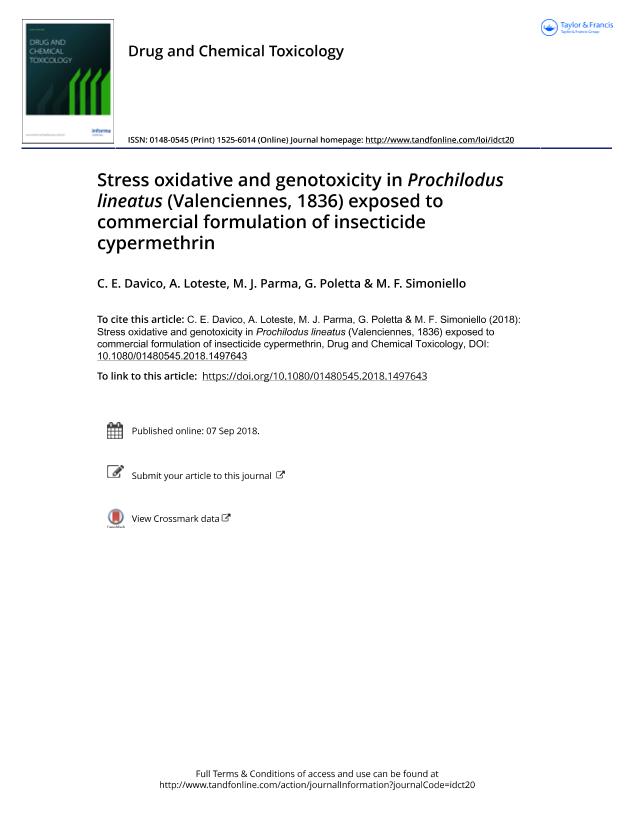Artículo
Stress oxidative and genotoxicity in Prochilodus lineatus (Valenciennes, 1836) exposed to commercial formulation of insecticide cypermethrin
Davico, Carla Eliana; Loteste, Alicia Elena ; Parma, Maria Julieta E.
; Parma, Maria Julieta E. ; Poletta, Gisela Laura
; Poletta, Gisela Laura ; Simoniello, Maria Fernanda
; Simoniello, Maria Fernanda
 ; Parma, Maria Julieta E.
; Parma, Maria Julieta E. ; Poletta, Gisela Laura
; Poletta, Gisela Laura ; Simoniello, Maria Fernanda
; Simoniello, Maria Fernanda
Fecha de publicación:
09/2018
Editorial:
Taylor & Francis
Revista:
Drug And Chemical Toxicology
ISSN:
0148-0545
Idioma:
Inglés
Tipo de recurso:
Artículo publicado
Clasificación temática:
Resumen
The use of toxic pesticides has become a world problem because they can contaminate streams and rivers, producing an adverse impact on non-target aquatic biota, including fishes. Cypermethrin is one of the most important insecticides to control ectoparasites in wide-scale. The aim of this study was to evaluate the effect of commercial formulations of cypermethrin, SHERPA O (0.0, 0.075, 0.15, and 0.3 mg/L of cypermethrin) in fish Prochilodus lineatus for 96 h in semi-static condition, using biomarkers of genotoxicity:micronucleus frequency (MNF) in erythrocytes and biomarkers of oxidative damage: lipid peroxidation (TBARS) and antioxidant defenses, catalase (CAT) and glutathione (GSH) in liver tissue. Our results showed a significant decrease (p<0.05) of CAT at pesticide concentrations of 0.150 and 0.300 lg/L, but no significant difference was observed in TBARS or GSH in any exposed group(p>0.05) in comparison to the control. A significant increase was observed in the MNF in the group exposed to 0.3 lg/L of cypermethrin compared to negative control (p<0.05). Finally, P. lineatus proved to be a sensitive species to the commercial formulations of cypermethrin and that CAT and MNF are effective indicators of these toxic effects
Palabras clave:
FISH
,
LIVE TISSUE
,
BIOMARKERS
,
CATALASE
Archivos asociados
Licencia
Identificadores
Colecciones
Articulos(INALI)
Articulos de INST.NAC.DE LIMNOLOGIA (I)
Articulos de INST.NAC.DE LIMNOLOGIA (I)
Citación
Davico, Carla Eliana; Loteste, Alicia Elena; Parma, Maria Julieta E.; Poletta, Gisela Laura; Simoniello, Maria Fernanda; Stress oxidative and genotoxicity in Prochilodus lineatus (Valenciennes, 1836) exposed to commercial formulation of insecticide cypermethrin; Taylor & Francis; Drug And Chemical Toxicology; 9-2018; 1-6
Compartir
Altmétricas



